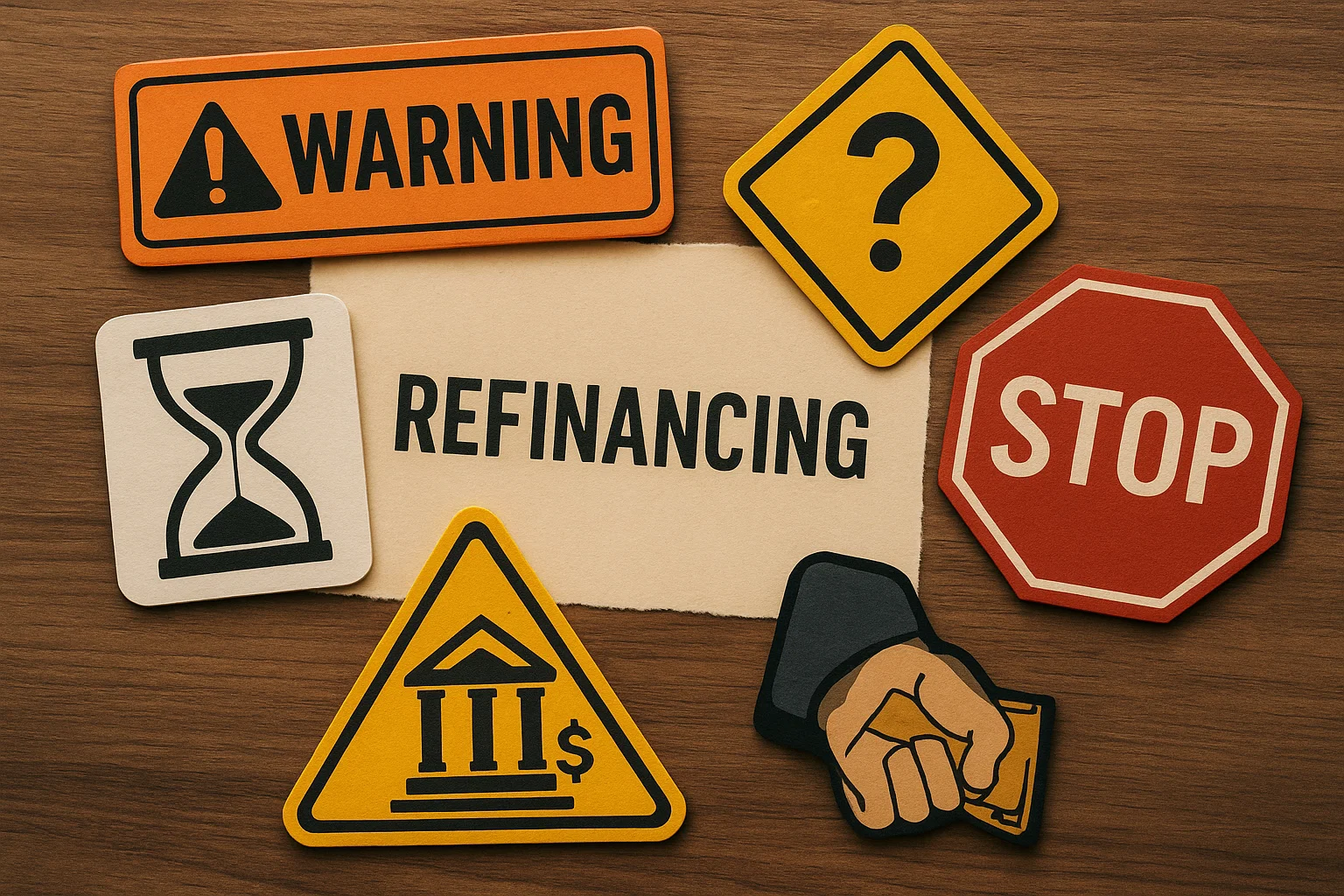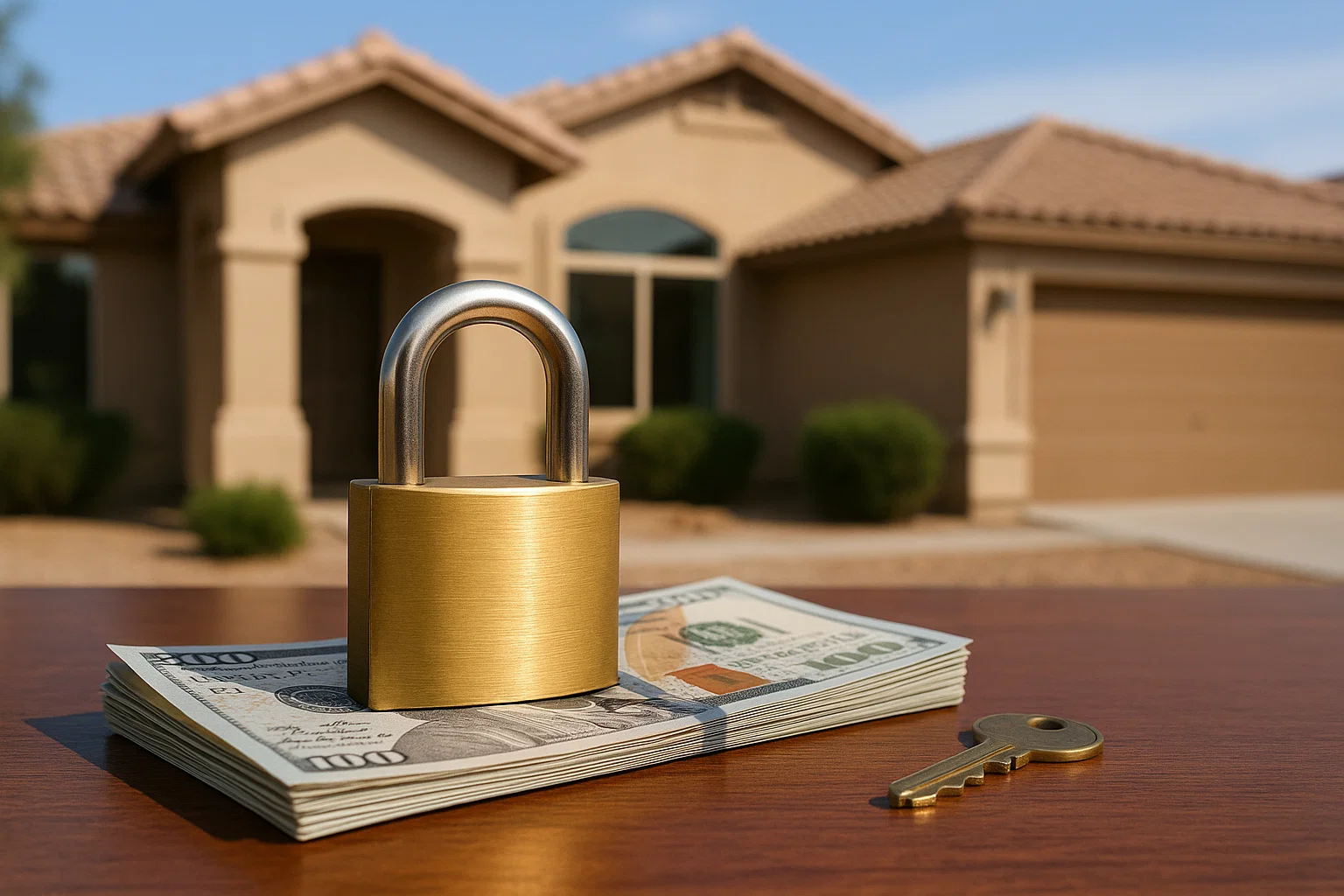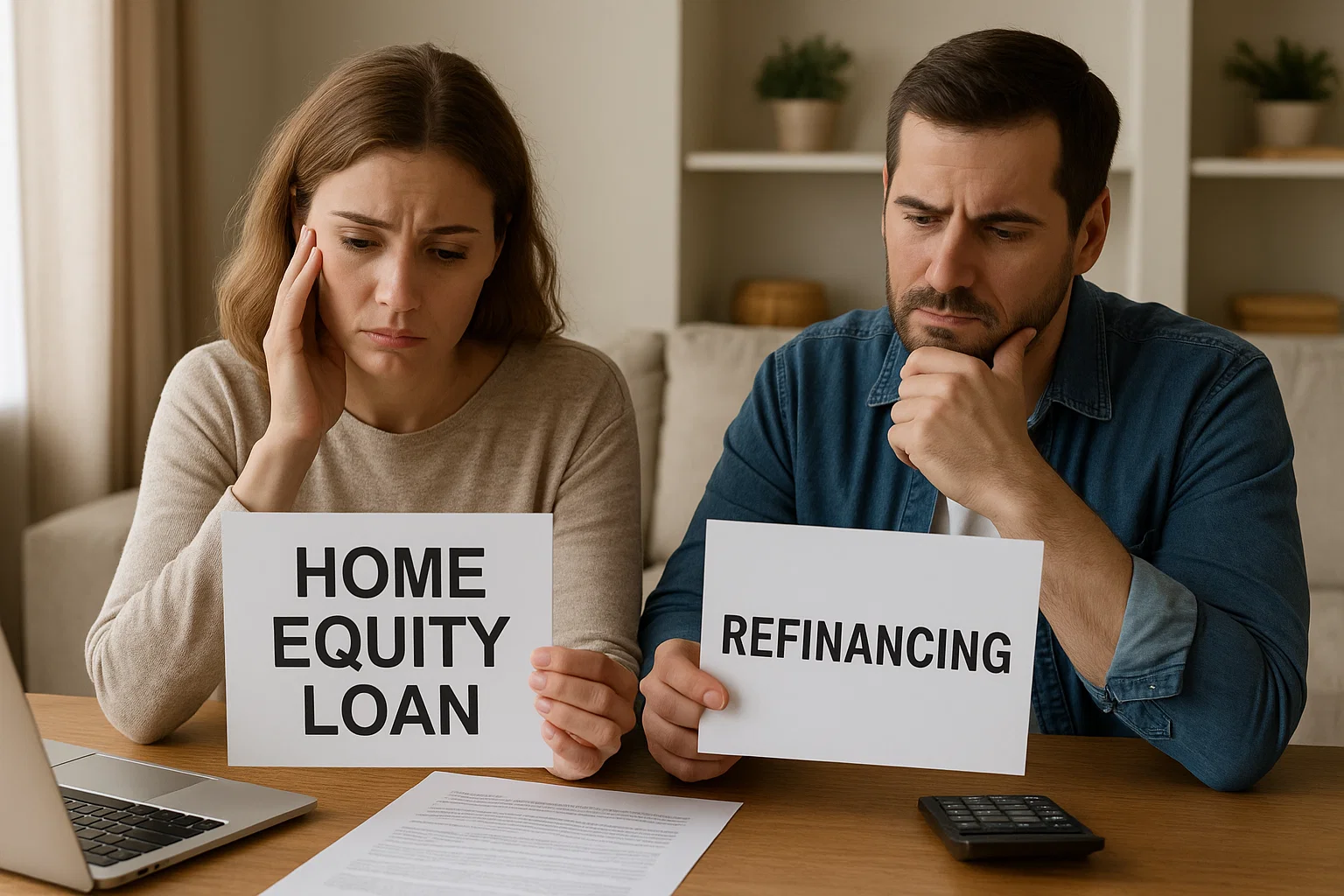.png)
Refinancing often appears as the financial solution to every mortgage challenge—such as lowering your rate, accessing cash, reducing payments, or eliminating Private Mortgage Insurance (PMI). The mortgage industry markets refinancing aggressively, and financial media frequently promotes it as smart money management. However, refinancing is not universally beneficial, and pursuing it at the wrong time or for the wrong reasons can actually damage your financial position rather than improving it.
Understanding when refinancing works against your interests requires an honest assessment of timing, motivations, costs, and long-term implications. Recognizing the warning signs that refinancing would prove counterproductive protects you from expensive mistakes disguised as opportunities. Sometimes, despite tempting refinancing offers, the most financially savvy decision means keeping your existing mortgage.
Understanding Refinancing's Hidden Costs
Refinancing involves substantial upfront expenses that many borrowers overlook or underestimate entirely. Closing costs typically range from 2–6% of the new loan amount. These costs include appraisal charges, application fees, title searches, various administrative expenses, origination points, and attorney fees. On a ₹50 lakh mortgage, this translates to ₹1–3 lakh in immediate out-of-pocket costs.
While lenders often allow these costs to be rolled into the new mortgage principal, this seemingly convenient option means you are paying interest on closing costs for the loan’s entire duration. Essentially, you are borrowing money to pay for the privilege of borrowing money. For example, a ₹2 lakh closing cost rolled into your mortgage at 8% interest over 20 years ultimately costs approximately ₹4.5 lakh when accounting for cumulative interest charges.
The break-even timeline—how long you must remain in your home for accumulated savings to offset closing costs—becomes critical. If closing costs total ₹1.5 lakh and refinancing saves ₹3,000 monthly, you break even in 50 months (just over four years). If you sell, move, or refinance again before reaching that point, you have spent ₹1.5 lakh for no financial benefit whatsoever.
Refinancing also consumes time and energy, beyond the direct financial costs. Gathering documentation, comparing lenders, undergoing credit checks, arranging appraisals, and managing closing logistics requires significant effort. For marginal financial benefit or uncertain outcomes, this investment of personal resources may not justify the potential returns.
Warning Signs Refinancing May Be Wrong

Refinancing may be the wrong move if any of the following warning signs apply:
- You plan to move or sell within three years. Short ownership timelines rarely allow sufficient time for monthly savings to recover closing costs.
- Interest rate reduction is less than 0.5%. Minimal rate differences typically do not generate enough savings to justify the refinancing expenses and effort.
- You're resetting a nearly-paid mortgage to 30 years. Extending your loan term dramatically increases lifetime interest, despite resulting in lower monthly payments.
- You're refinancing to fund discretionary spending. Using home equity for lifestyle expenses, luxury purchases, or vacations rather than strategic investments threatens long-term financial security.
When Timing Works Against Refinancing
Late-stage mortgage holders—those with fewer than ten years remaining on their loans—often discover refinancing works against their interests, even with seemingly attractive rates. This is because mortgage amortization front-loads interest payments. Homeowners who have been paying mortgages for 15–20 years have crossed the amortization curve’s inflection point, meaning their payments now substantially reduce principal rather than padding lender profits.
Refinancing at this stage resets the amortization schedule, placing you back at the beginning where interest dominates each payment. Even if the interest rate is lower, restarting a 20–30 year mortgage when you only had 8–10 years remaining means dramatically more total interest paid and years added to your debt obligation. The lower monthly payment masks the fact that you are extending debt that would have ended soon, potentially carrying mortgages into retirement years when income typically decreases.
Economic uncertainty also creates problematic refinancing timing. During periods of business volatility, employment instability, or career transitions, committing to new mortgage terms—which might involve higher payments if taking cash out or shortening terms—introduces risk precisely when financial flexibility matters most. Refinancing during instability locks you into obligations that may become unsustainable if income disruptions occur.
Rising interest rate environments similarly create timing challenges. If your current mortgage rate is 7.5% but prevailing refinancing rates have climbed to 9%, refinancing is financially irrational for any reason except critical cash-out needs. In this scenario, you would be replacing a favourable rate with a worse one, increasing both lifetime interest costs and monthly payments.
Rushing to refinance without strategic patience sometimes means missing better opportunities that would have emerged with modest waiting. Market-timing mistakes prove particularly costly when homeowners refinance during temporary rate dips without recognising they could be paying down existing mortgages and refinancing even more advantageously later.
When Motivations Undermine Financial Health
Refinancing to fund lifestyle inflation—such as purchasing luxury items, financing vacations, or upgrading vehicles—represents one of the most dangerous motivations. This approach converts secured home equity into consumption rather than investment, simultaneously increasing mortgage debt while acquiring depreciating assets. The home becomes a personal ATM instead of a wealth-building foundation, gradually eroding financial security for temporary lifestyle enhancements.
A destructive cycle is created when refinancing is used repeatedly to consolidate debt without addressing underlying spending patterns. Homeowners who refinance to pay off credit cards, then reaccumulate credit card debt, and then refinance again to consolidate the new debt find themselves with progressively larger mortgages and persistent spending problems. Each cycle converts unsecured debt (which cannot seize your home) into secured mortgage debt (which can lead to foreclosure), dramatically raising the stakes of financial mismanagement.
Refinancing based solely on peer pressure or aggressive marketing rather than a clear personal financial advantage leads to regrettable decisions. Your existing mortgage rate, remaining term, equity position, future plans, and financial goals determine whether refinancing makes sense—not advertisements or the fear of missing out.
Chasing every marginal rate drop also proves counterproductive. Homeowners who refinance whenever rates drop 0.25% accumulate substantial closing costs across multiple refinances, often negating the cumulative savings from the rate reductions. Strategic refinancing focuses on significant rate differentials (1%+ reductions) rather than constant churning for minimal gains.
Situations Where Alternatives Prove Superior

Sometimes, simpler approaches deliver the desired outcomes of refinancing without the associated risks, costs, or complexity.
Homeowners wanting to eliminate PMI might request removal directly from their current lender once equity reaches 20%. This process only requires an updated appraisal (costing ₹10,000–15,000) rather than full refinancing costs. Likewise, those wanting accelerated payoff can simply make additional principal payments without refinancing to shorter terms.
For smaller amounts (under ₹5 lakh) or when existing mortgage rates are favourable, personal loans or lines of credit sometimes provide needed funds more efficiently than cash-out refinancing. Although interest rates may be higher, the lower upfront costs, preservation of advantageous mortgage terms, and simpler approval processes can make unsecured borrowing the wiser choice.
Home equity lines of credit (HELOCs) offer flexible access to equity without replacing existing mortgages. HELOCs are ideal when only modest funds are needed and current mortgage rates are below market rates. They function like credit cards secured by home equity, enabling you to borrow only what you need when you need it, rather than taking lump sums through cash-out refinancing.
Loan modification programs from existing lenders can sometimes adjust terms without requiring full refinancing, which is particularly valuable during financial hardship. These modifications can extend terms, or temporarily reduce or defer payments, without the costs and credit impacts of complete refinancing.
Critical Questions Before Proceeding
Before proceeding, you should ask yourself these critical questions:
- Have you calculated your true break-even timeline including all costs? You must ensure you will remain in the property substantially beyond this point to justify refinancing.
- Are you extending your loan term significantly? Calculate total interest over the new loan life versus remaining payments on your existing mortgage.
- Does your motivation align with long-term wealth building? Ensure you are refinancing for strategic investment rather than lifestyle inflation or consumption.
- Have you explored simpler alternatives? Consider whether home equity loans, additional principal payments, or direct PMI removal might serve your needs more efficiently.
- Are you addressing root financial issues? If debt consolidation is your goal, ensure behavioural changes prevent debt reaccumulation that would worsen your position.
Making Informed Refinancing Decisions
Smart refinancing decisions require comprehensive, honest analysis rather than emotional reactions to surface-level rate comparisons or marketing messages.
You must begin by calculating your exact break-even point using realistic assumptions about how long you will remain in your property. Only proceed if you are confident you will stay substantially beyond this timeline—ideally at least two years past break-even to justify the effort and risk.
Model complete scenarios including all costs and long-term implications. Calculate the total interest paid over your existing mortgage's remaining life versus the total interest under the proposed refinance. Lower monthly payments sometimes mask dramatically higher lifetime costs due to extended terms or higher principal amounts.
Evaluate your motivations critically. Write down exactly what you hope to achieve and why you are considering refinancing. If your reasons centre on vague desires for "extra cash," following what others are doing, or funding consumption rather than investment, recognise these as warning signs that refinancing may not serve your interests.
Consult with financial advisors who do not earn commissions from mortgage originations, such as fee-only planners or housing counselors. These professionals provide objective guidance rather than sales-motivated recommendations, helping you evaluate whether refinancing genuinely advances your financial goals or simply generates fees for lenders.
Sometimes, the smartest financial decision involves saying no to refinancing, despite persistent marketing and attractive presentations. Maintaining your current mortgage when it features favourable terms, or when your circumstances do not justify the transition, demonstrates financial discipline. This serves long-term wealth building better than constant attempts at optimisation.
Approach refinancing decisions with rigorous analysis and healthy skepticism. Not every refinancing opportunity represents a genuine opportunity—many prove to be expensive distractions that complicate finances without delivering meaningful benefit. By recognising when refinancing doesn't make sense and having the discipline to maintain your current mortgage, you avoid costly mistakes while preserving the financial progress you have already made toward mortgage-free homeownership.

Alex Chen

Alex Chen













Get in touch with a loan officer
Our dedicated loan officers are here to guide you through every step of the home buying process, ensuring you find the perfect mortgage solution tailored to your needs.
Options
Exercising Options
Selling
Quarterly estimates
Loans
New home

Stay always updated on insightful articles and guides.
Every Monday, you'll get an article or a guide that will help you be more present, focused and productive in your work and personal life.









.png)
.png)
.png)
.png)
.png)
.png)
.png)
.png)
.png)
.png)
.png)
.png)
.png)
.png)
.png)
.png)
.png)
.png)